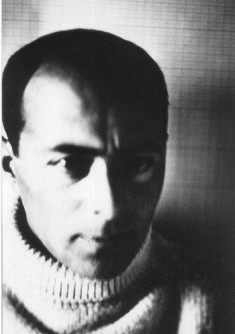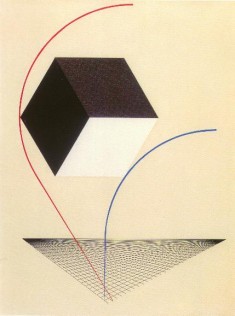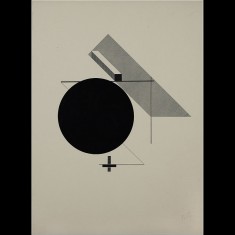| El Lissitzky | |
|---|---|
 |
|
| Born | Lazar Markovich Lissitzky Nov. 23, 1890 Pochinok, Russian Empire |
| Died | Dec. 30, 1941 (at age 51) Moscow, USSR |
| Nationality | Russian |
| Movement | Suprematist |
| Field | Painting |
| Works | |
Lazar Markovich Lissitzky, better known as El Lissitzky (1890-1941), was a Russian-born painter, designer, artist, teacher, typographer, photographer, architect, illustrator and theorist. He was born on November 23, 1890, in Pochinok, Russian Federation.
Lissitzky was one of the people hired to create propaganda in the early 20th century for the Soviet Union. His ideas were developed and influenced by the Suprematist art movement. He was greatly influential in developing the Constructivist art and the Bauhaus movements. His stylistic experimentation and characteristics with production techniques were developed during the early 1920s and 1930s and they have been a great influence on several well known graphic designers since.
Lissitzky’s Prouns and Paintings
In his earlier years, Lissitzky developed his own unique style of painting. He used abstract geometric shapes in his work. He referred to these shapes as “prouns” and defined the spatial relationship of his compositions. These shapes had been created in a three-dimensional space and they often contained changing perspectives. This was a direct result of the contrast to the Suprematist theories and ideas, which stressed on the simplification of geometric shapes as well as the usage of two-dimensional spaces only.
Lissitzky’s Popular Works
 Proun was basically Lissitzky’s journey in which he explored a visual language involving suprematism with the help of spatial elements. He utilized the concepts of shifting axes and multiple perspectives, both of which were uncommon ideas in suprematism.
Proun was basically Lissitzky’s journey in which he explored a visual language involving suprematism with the help of spatial elements. He utilized the concepts of shifting axes and multiple perspectives, both of which were uncommon ideas in suprematism.
During that time, suprematism was mostly conducted exclusively in two-dimensional form, flat form, and shapes. Lissitzky, with his refined taste for various three-dimensional concepts and architecture, tried to expand his suprematism style beyond this.
Among Lissitzky’s best works, his Proun works (also referred to as Prounen), evolved over half a decade. It developed from lithographs and straightforward paintings into a complete three-dimensional installation. This also laid the foundation for all his future experiments in exhibition design and architecture.
Although his paintings were extremely artistic in their own unique way, their significance was essentially derived as a foundation ground for all of his early architectonic concepts. These ideas revolved around the basic architectural elements of mass, volume, space, rhythm and color. Thus, they were introduced to a new perspective in relation to several fresh suprematist ideals.
Book Designs and Typography
 El Lissitzky was a significant personality in Russian avant garde. He helped develop suprematism along with Kazimir Malevich, who was also his mentor. Lissitzky experimented with stylistic devices and production techniques that went on to dominate 20th century graphic designs.
El Lissitzky was a significant personality in Russian avant garde. He helped develop suprematism along with Kazimir Malevich, who was also his mentor. Lissitzky experimented with stylistic devices and production techniques that went on to dominate 20th century graphic designs.
Through his Prouns, Lissitzky developed several utopian models to create a new and improved world. This type of an outlook in which an artist manages to create artwork with a socially defined objective is often referred to as “task oriented creation.”
Many Jewish symbols and themes also made an appearance within his Prounen. This was usually done with Lissitzky implementing Hebrew letters as an integral part of the visual code or typography.
On the cover of the book Arba’ah Teyashim (the 1922 book Four Billy Goats), Lissitzky shows an arrangement with Hebrew letters as a key architectural element within the dynamic design. This has mirrored his distinct style of a contemporary Proun typography. Later, this theme was also used in his illustrations of the book Shifs-Karta (also known as Passenger Ticket).
Lissitzky’s Later Years
Lissitzky traveled around Europe in the 1920s and spent a fair amount of time in both Switzerland and Germany. He moved around Germany in the 1920s as Russia’s cultural representative. After being diagnosed with a serious condition of pulmonary tuberculosis, he spent time in a sanatorium in Switzerland. However, this never deterred him from working. He continued to write books, create propaganda posters, and design exhibitions and buildings for the Soviet Union.
In the year 1932, Stalin ordered that every artist must conform to far more stringent guidelines or they will be blacklisted. While Lissitzky did manage to retain his post as the head of exhibitions, his tuberculosis overcame him and caused his death on December 30, 1941, in Moscow.